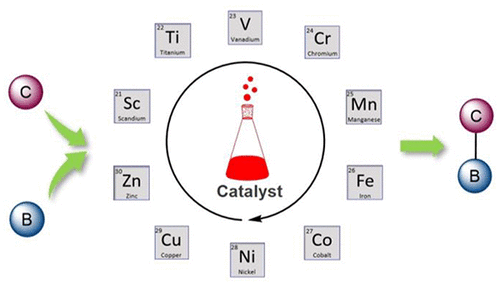当前位置:
X-MOL 学术
›
Chem. Rev.
›
论文详情
Our official English website, www.x-mol.net, welcomes your
feedback! (Note: you will need to create a separate account there.)
First-Row d-Block Element-Catalyzed Carbon–Boron Bond Formation and Related Processes
Chemical Reviews ( IF 51.4 ) Pub Date : 2021-10-07 , DOI: 10.1021/acs.chemrev.1c00255 Shubhankar Kumar Bose 1 , Lujia Mao 2 , Laura Kuehn 3 , Udo Radius 3 , Jan Nekvinda 4 , Webster L Santos 4 , Stephen A Westcott 5 , Patrick G Steel 6 , Todd B Marder 3
Chemical Reviews ( IF 51.4 ) Pub Date : 2021-10-07 , DOI: 10.1021/acs.chemrev.1c00255 Shubhankar Kumar Bose 1 , Lujia Mao 2 , Laura Kuehn 3 , Udo Radius 3 , Jan Nekvinda 4 , Webster L Santos 4 , Stephen A Westcott 5 , Patrick G Steel 6 , Todd B Marder 3
Affiliation

|
Organoboron reagents represent a unique class of compounds because of their utility in modern synthetic organic chemistry, often affording unprecedented reactivity. The transformation of the carbon–boron bond into a carbon–X (X = C, N, and O) bond in a stereocontrolled fashion has become invaluable in medicinal chemistry, agrochemistry, and natural products chemistry as well as materials science. Over the past decade, first-row d-block transition metals have become increasingly widely used as catalysts for the formation of a carbon–boron bond, a transformation traditionally catalyzed by expensive precious metals. This recent focus on alternative transition metals has enabled growth in fundamental methods in organoboron chemistry. This review surveys the current state-of-the-art in the use of first-row d-block element-based catalysts for the formation of carbon–boron bonds.
中文翻译:

第一行 d-block 元素催化的碳-硼键形成及相关过程
有机硼试剂代表了一类独特的化合物,因为它们在现代合成有机化学中的实用性,通常提供前所未有的反应性。以立体控制的方式将碳-硼键转变为碳-X(X = C、N 和 O)键在药物化学、农业化学、天然产物化学以及材料科学中具有不可估量的价值。在过去十年中,第一排 d 区过渡金属越来越广泛地用作形成碳 - 硼键的催化剂,这种转变传统上由昂贵的贵金属催化。最近对替代过渡金属的关注促进了有机硼化学基础方法的发展。这篇评论调查了当前最先进的技术在使用第一排 d 区元素基催化剂形成碳 - 硼键时。
更新日期:2021-11-10
中文翻译:

第一行 d-block 元素催化的碳-硼键形成及相关过程
有机硼试剂代表了一类独特的化合物,因为它们在现代合成有机化学中的实用性,通常提供前所未有的反应性。以立体控制的方式将碳-硼键转变为碳-X(X = C、N 和 O)键在药物化学、农业化学、天然产物化学以及材料科学中具有不可估量的价值。在过去十年中,第一排 d 区过渡金属越来越广泛地用作形成碳 - 硼键的催化剂,这种转变传统上由昂贵的贵金属催化。最近对替代过渡金属的关注促进了有机硼化学基础方法的发展。这篇评论调查了当前最先进的技术在使用第一排 d 区元素基催化剂形成碳 - 硼键时。











































 京公网安备 11010802027423号
京公网安备 11010802027423号